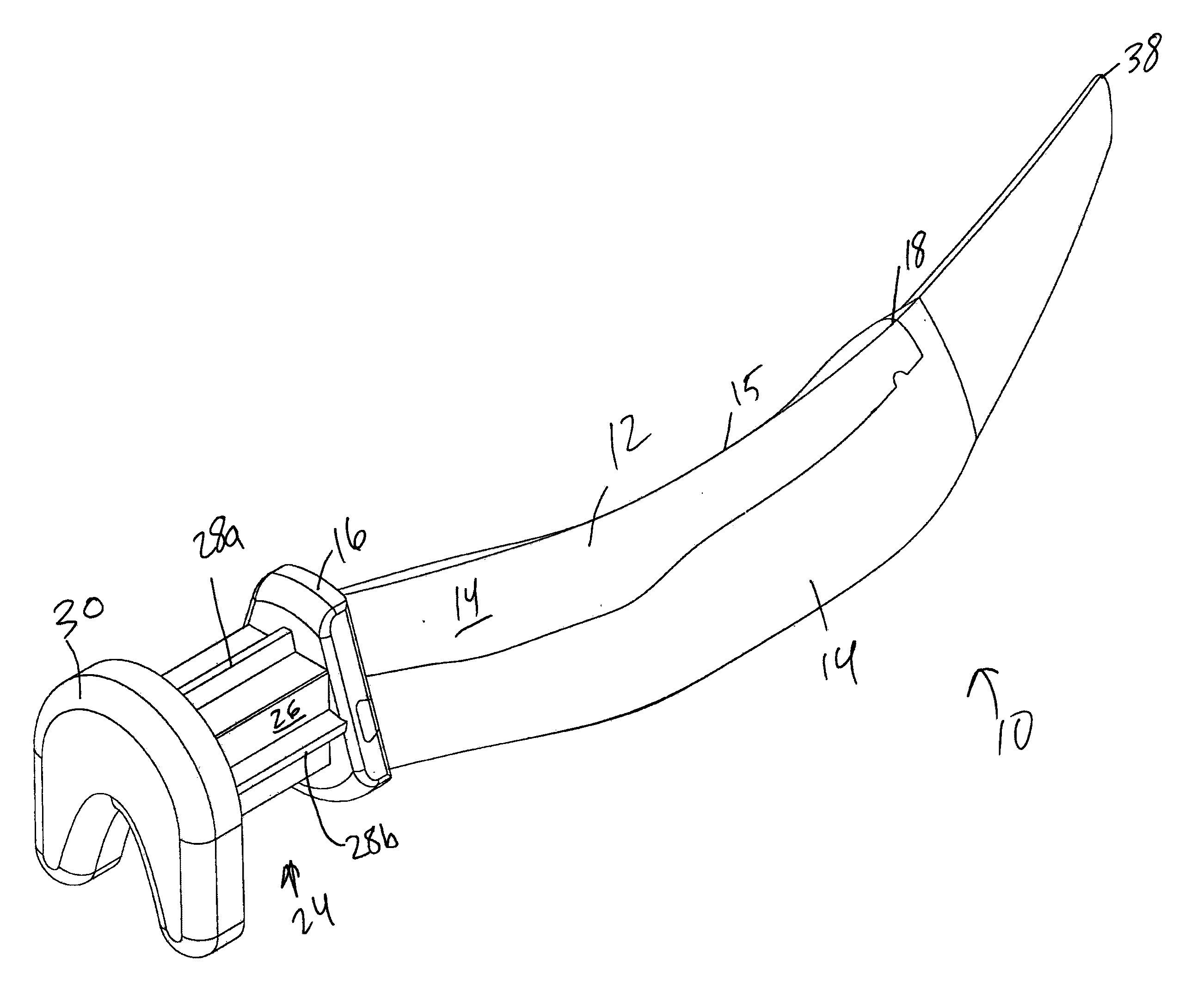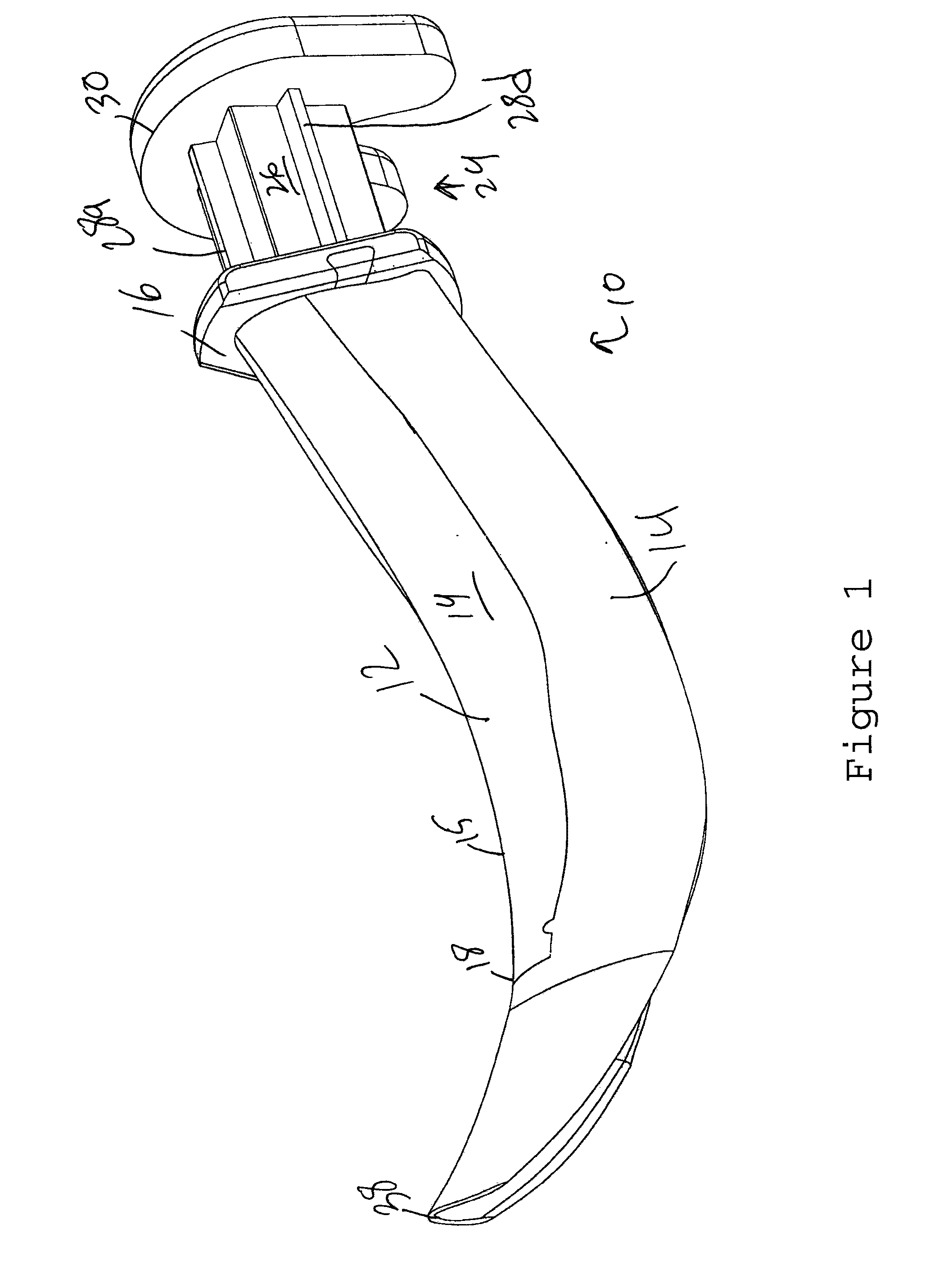Dental Wedge
- Summary
- Abstract
- Description
- Claims
- Application Information
AI Technical Summary
Benefits of technology
Problems solved by technology
Method used
Image
Examples
first embodiment
[0116]Turning to FIGS. 1 to 16, a dental wedge 10 according to the invention is shown. The dental wedge 10 includes a top section 12 and a bottom section 14. The use of relative terms such as “top”, “bottom”, “front”, “rear”, “inner”, “left”, “outer”, “right”, and the like when describing the dental wedges of the invention is not intended to limit the orientation in which the dental wedge 10 may be used. Such relative terms merely serve to more conveniently describe the invention. Unless the context clearly indicates the contrary, “top” will refer to the direction toward the closed end of the dental wedge, “bottom” will refer to the direction toward the open end of the dental wedge, “inner” or “left” will refer to the direction toward the end of the dental wedge that is first inserted between adjacent teeth, “outer” or “right” will refer to the direction toward the end of the dental wedge that is grasped when the dental wedge is inserted between adjacent teeth, “front” will refer to...
second embodiment
[0132]Turning to FIGS. 17 to 24, a dental wedge 110 according to the invention is shown. The dental wedge 110 includes a top section 112 and a bottom section 114. The use of relative terms such as “top”, “bottom”, “front”, “rear”, “inner”, “left”, “outer”, “right”, and the like when describing the dental wedge 110 of the invention is not intended to limit the orientation in which the dental wedge 110 may be used as explained above.
[0133]The top section 112 has a generally arcuate top surface 119 and a rounded top edge 115 that extends from a first vertical land area 116 to a paper thin (e.g., 0.001″-0.050″) collapsing distal tip 138 that is inward from the end of the wedge 110. Extending away from the vertical land area 116 opposite the tip 138 is a first grasping section 124 having a base 126 and splines 128a, 128b, 128c and 128d that extend outwardly from the base 126. The splines 128a, 128b, 128c and 128d are generally plate-like but can also have other shapes. Extending away fro...
third embodiment
[0138]Turning to FIGS. 25-31, a dental wedge 310 according to the invention is shown. The dental wedge 310 includes a top section 312 and a bottom section 314. The use of relative terms such as “top”, “bottom”, “front”, “rear”, “inner”, “left”, “outer”, “right”, and the like when describing the dental wedge 310 is not intended to limit the orientation in which the dental wedge 310 may be used as explained above.
[0139]The top section 312 has a generally arcuate top surface 319 and a rounded top edge 315 that extends from a first vertical land area 316 to an end 318 that is inward from the end of the wedge 310. The top section 312 has a central longitudinal body 320 that extends from the land area 316 to the end 318. The body 320 is located below the top surface 319. Extending away from the first vertical land area 316 opposite the end 318 is a first grasping section 324 having a base 326 and splines 328a, 328b, 328c and 328d that extend outwardly from the base 326. The splines 328a, ...
PUM
 Login to View More
Login to View More Abstract
Description
Claims
Application Information
 Login to View More
Login to View More - Generate Ideas
- Intellectual Property
- Life Sciences
- Materials
- Tech Scout
- Unparalleled Data Quality
- Higher Quality Content
- 60% Fewer Hallucinations
Browse by: Latest US Patents, China's latest patents, Technical Efficacy Thesaurus, Application Domain, Technology Topic, Popular Technical Reports.
© 2025 PatSnap. All rights reserved.Legal|Privacy policy|Modern Slavery Act Transparency Statement|Sitemap|About US| Contact US: help@patsnap.com



